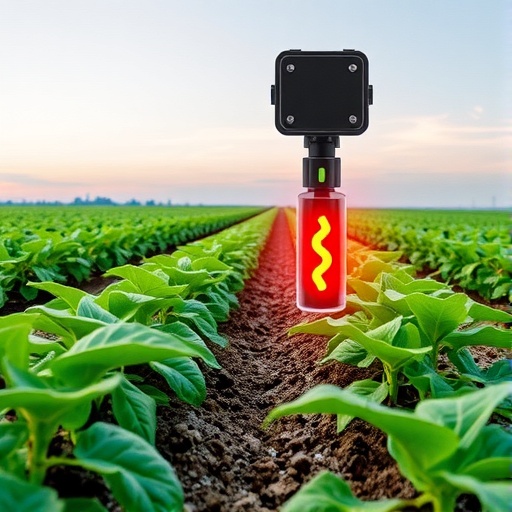In an era where the need for sustainable agriculture is increasingly paramount, the detection of gases like ammonia, often released from fertilizers and livestock, becomes essential for developing effective environmental protection strategies. Recent advancements have seen the emergence of sophisticated electronic nose systems designed to accurately identify such gases, ensuring that farmers can respond proactively to potential environmental hazards. A significant leap forward in this domain has been made by researchers Du et al., who have ingeniously combined sensor technology with advanced machine learning techniques to enhance the detection of agricultural ammonia.
The team concentrated on developing a unique sensor array combining tungsten trioxide (WO3) and zinc oxide (ZnO), materials known for their fee characteristics and sensitivity to gaseous compounds. The WO3-ZnO sensor array is a pivotal component in the electronic nose systems and operates on the principle of changing electrical resistance upon exposure to various target gases. This dual-material composition optimizes the sensor array’s ability to detect ammonia, providing improved selectivity and minimizing interference from other gases commonly present in agricultural environments.
To maximize the efficacy of the sensor data collected, the researchers integrated a convolutional neural network (CNN) with their electronic nose system. CNNs, a class of deep learning algorithms particularly well-suited for classification tasks, have the ability to learn complex patterns within datasets. This approach allows the electronic nose not only to detect ammonia but also to distinguish it from other gases, thus enhancing its practical application in real-world agricultural settings.
The study underscores the importance of machine learning in modern sensor technology. In traditional gas detection methods, results can sometimes be erratic or inaccurate due to the overlap of chemical properties among different substances. However, through the use of CNNs, researchers can train their systems using vast datasets, ultimately refining the sensors to attain superior discrimination capabilities. This machine-learning aspect represents a revolutionary change from earlier techniques, which depended heavily on human interpretation and manual calibration.
Field trials conducted by the researchers demonstrated the increased operational reliability of their newly designed electronic nose systems. When tested against control systems, the WO3-ZnO sensor array showcased a remarkable ability to not only detect ammonia gas at lower concentrations but also to do so with greater accuracy and reduced false positives. Such improvements signal a robust potential for these systems, particularly for agricultural applications where precise gas detection is necessary for mitigating risk of atmospheric pollution.
The implications of this research extend beyond mere gas detection; they offer a glimpse into a future where agricultural practices can be harmoniously aligned with environmental stewardship. By efficiently monitoring ammonia levels, farmers can make informed decisions about fertilizer use, thus optimizing crop yield while minimizing detrimental impacts on the environment. This could lead to a significant reduction in nitrogen run-off, a known contributor to waterway degradation and associated ecological issues.
Moreover, the integration of technology in agriculture is crucial to addressing global food security challenges. As the world population rises, so does the demand for food. It is essential that agricultural practices evolve through the adoption of cutting-edge technologies. The successful development of enhanced electronic nose systems, like those articulated in this study, represents a pivotal point where technology can directly contribute to sustainable agricultural practices.
The combination of advanced materials science and machine learning establishes a new paradigm for sensor technology aimed at agricultural monitoring. Future research and development could spur the creation of more sophisticated multi-gas sensor arrays capable of real-time monitoring of various agricultural gases, driving further innovation in the sector. With climate change and environmental conservation at the forefront of global priorities, studies such as this one contribute valuable knowledge necessary for fostering a more sustainable future.
Furthermore, the affordability and accessibility of such electronic nose technologies could democratize agricultural monitoring. If made widely available, these systems could empower smaller farms, ensuring that even those with limited resources can engage in environmentally conscious practices. Accessibility to technology is a vital factor in sustainable agriculture, and through ongoing innovation, researchers might bridge existing gaps in the agricultural sector.
As we look towards the future of agricultural practices, the collaborative efforts between scientists, engineers, and farmers will be crucial. The effective communication of these technological advancements can enhance the industry’s adaptability to changing environmental conditions. Stakeholders across the agricultural domain must remain engaged in discourse around technology adoption, fostering a community of forward-thinking practices that prioritize sustainability.
The pioneering work showcased by Du et al. stands as a testament to the power of interdisciplinary research involving materials science, machine learning, and agriculture. It raises the question of what other innovations are on the horizon that could solve pressing environmental challenges. As researchers continue to innovate, the agricultural landscape can expect a transformation driven by a blend of technological advancement and environmental consciousness.
In conclusion, the enhanced selectivity of electronic nose systems demonstrated by this study marks a significant advancement in agricultural gas detection technology. By optimizing a WO3-ZnO sensor array in conjunction with convolutional neural networks, the researchers have set a new standard for ammonia detection, offering promising implications for sustainable agricultural practices. As these technologies continue to develop, the potential for creating a harmonious balance between agricultural productivity and environmental health remains within reach.
Subject of Research: Agricultural Ammonia Gas Detection
Article Title: Enhanced Selectivity Electronic Nose Systems for Agricultural Ammonia Gas Detection via a co-designed WO3-ZnO Sensor Array and Convolutional Neural Networks.
Article References:
Du, M., Abdulraheem, M.I., Xu, L. et al. Enhanced Selectivity Electronic Nose Systems for Agricultural Ammonia Gas Detection via a co-designed WO3-ZnO Sensor Array and Convolutional Neural Networks.
Sci Rep 15, 39100 (2025). https://doi.org/10.1038/s41598-025-26084-z
Image Credits: AI Generated
DOI: https://doi.org/10.1038/s41598-025-26084-z
Keywords: Ammonia detection, electronic nose systems, sensor technology, convolutional neural networks, sustainable agriculture.




